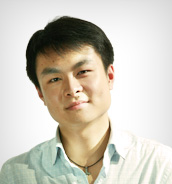4) 分句以so, neither, nor, no more等副词位于句首,表明前面句子中所说明的情况也使用于后面的句子时用倒装。
Copper is a good conductor. So are many other metals.
He didn’t see the film last night, neither did she.
2. 强调句型
这里讲的强调句主要是以it为引导词的分裂句。其构成形式为:It is (was) +被强调部分+ that(who, which) + 句子的其他部分。被强调的部分通常为主语、宾语和状语。
It is only when one is ill that one realizes the value of health.
It is what you will do that is essential.
Note:
在被强调部分的后面,一般用that引出句子的其他部分。但是如果强调的部分是表示人的名词,那么也可用who;如果是指物的名词也可用which。
It was Jane that/who lent me the money.
It was this novel that/which they talked about last night.
如果强调的是原因状语从句,只能用because引导,不能由since, as或why引导。
It was because(不用since或as) he had never had the opportunity that John hadn’t learned to drive.
有三类句子成分不可以进行强调,即表语、谓语动词和由though, although, whereas等引导的从句。
It is although he is young that he can speak four languages. (误)
Although he is young, he can speak four languages. (正)
It is whereas he prefers pop song that I like classical music. (误)
I like classical music whereas he prefers pop songs. (正)
3. 使役动词后的宾语补足语
使役动词除了要有宾语之外还要加上宾语补足语才能使句子的意义完整。常用的使役动词有:have, want, make, get, leave, set, let等。可以担当使役动词宾语补足语的有名词,形容词,介词短语,动词不定式和分词等。
All work and no play makes Jack a dull boy.
A good night’s rest will set you right.
Note:
动词不定式可以担当使役动词的宾语补足语,但在make, let, have等使役动词后,动词不定式作宾语补足语时不用to。
He made her give up the opportunity.
What would you have me do?
Her pride would not let her do this.
分词也可以担当使役动词的宾语补足语。现在分词表示正在进行的主动意义,而过去分词表示已经完成的被动意义。
Her remark left me wondering what he was driving at.
The joke set them all laughing.
He managed to get the job done on time.
I’ve just had some new photos taken.
4. 平行结构
在英语中,当两个或两个以上的同等成分(主语,谓语,宾语,表语,定语,状语,宾语补足语等)并列时,要求它们的词性或结构相同,即名词对名词,介词短语对介词短语,分词对分词,句子对句子等等。这就是英语的平行结构准则。一般在使用并列连词如and, but, or, neither … nor, either … or, not only .. but also, both … and, more(less) … than, as well as,rather… than等时,要注意不要违反平行结构准则。
He likes watching TV more than reading books.
The soldier preferred to die rather than surrender.
We saw Tom walking towards the river, taking off his clothes and plunging into the water.
Censorship prevents a movie from being shown or a book being sold.
5. 反意疑问句
在具体运用反意疑问句时应注意以下几点:
1) 如果陈述句部分是一个含有宾语从句的复杂句,则反意疑问部分的谓语动词和主语代词要与主句的谓语动词和主语相对应。
He never said she would come, did he?
You told me I had passed the exam, didn’t you?
但是如果陈述句部分是 “I (don’t) think, believe, suppose, imagine, expect, fancy, reckon等+宾语从句”的结构时,反意疑问部分的谓语动词和主语代词要与宾语从句的谓语动词和主语相对应,并且要注意否定的转移。
I suppose you are not serious, are you?
She imagines that people like her, don’t they?
I don’t believe she knows it, does she? (因don’t的否定意义后移而不用doesn’t)
I didn’t expect she would come, would she? (因didn’t的否定意义后移而不用wouldn’t)
2) 如果陈述句部分是祈使句,则反意疑问部分一般用“will you”。在否定祈使句后还是用“will you”。
Read the text, will you?
Don’t be late, will you?
如果陈述句部分是以Let’s开头的祈使句,则反意疑问部分一般用“shall we”;如果是以Let us开头的祈使句,则反意疑问部分一般用“will you”。
Let’s have a party tonight, shall we?
Let us go home, will you?
3) 如果陈述句部分带有never, nothing, nowhere, hardly, scarcely, seldom, rarely, barely, little, few等否定词或半否定词,反意疑问部分的动词要用肯定式。
You can hardly believe this, can you?
He has few good reasons for staying, has he?
6. 词序
当多个形容词共同修饰一个名词时,在意义上同名词关系最密切的词最靠近该名词,其排列次序为“A + B + C + D + E + F + G + 被修饰的名词”。其中:A. 表示年龄、新旧的形容词,如old, young等。B. 表示大小、长短、高低、重量的形容词,如little, big, long, heavy等。 C. 表示形态、形状的形容词,如round, square等。D. 表示颜色的形容词,如red, white, green等。E. 表示国籍、地区、出处的形容词,如British, southern, Italian等。F. 表示物质、材料的形容词,如wooden, rocky等。G. 表示用途、类别、目的、与…有关等的形容词,也包括起形容词作用的名词和分词,如medical, writing, geography等。其他形容词放在上述A类形容词之前。例如:
a small round brown wooden table
a useless, old, big, heavy, red geography book
a valuable old French writing desk
a strong young Chinese boy student
7. 一些特殊的句型
1) there is no point in doing sth.
该句型意为“做…是无济于事的/没有什么用的”。可以用very little 或not much等来代替no。其中的point是不可数名词,作“目的”、“用处”解。
There is very little point in arguing with him.
2) have difficulty (or trouble) in doing sth.
该句型意为“做…有困难”。其中的in可以省略;其中的difficulty和trouble是不可数名词,不能有复数形式。也可以用there is difficulty(or trouble) in doing sth.表达相同的意思。
There was little difficulty in finding him.
3) keep (sb. or sth. ) busy doing sth.
该句型意为“使…一直忙着做某事”。需注意的是虽然busy with doing sth.和busy in doing sth.都是正确的,但考题中常考busy doing sth.句型。但如果busy后面跟的是名词,则要用busy with sth.。
We are busy preparing for the examination.
4) feel like doing sth.
该句型意为“想做某事”,且feel like后只能跟动名词,而不能跟动词不定式。此外,feel like后还可跟名词或代词,表示“想要某物”。
I was so angry that I felt like throwing something at him.
I feel like beer tonight.
相关推荐:
2010年12月英语四六级考试写作常用谚语500句 2010年12月大学英语四级词汇活记活用汇总














